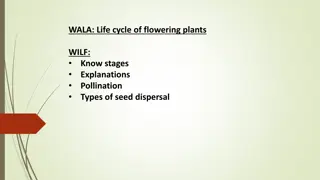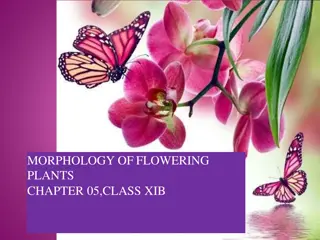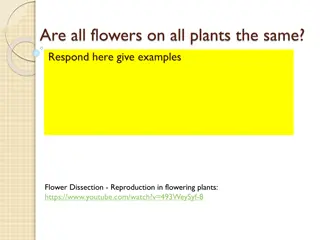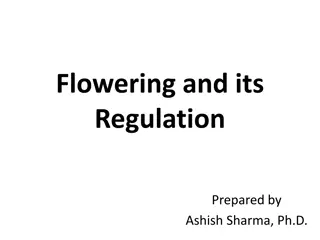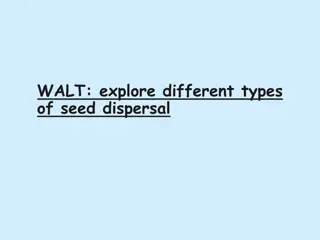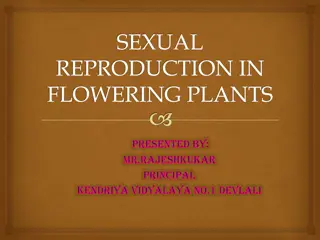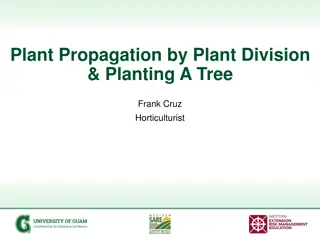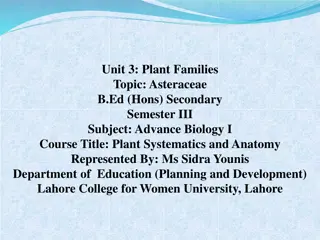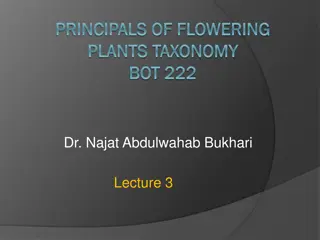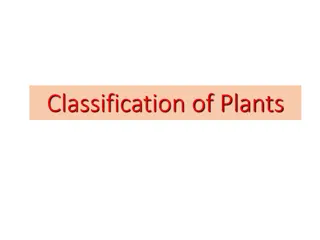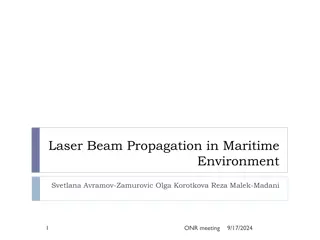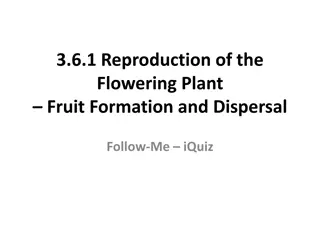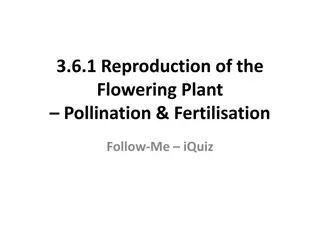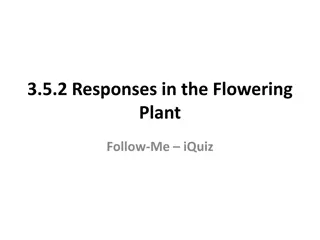Understanding Vegetative Propagation in Flowering Plants
This content explores the concept of vegetative propagation in flowering plants, focusing on asexual reproduction, flower structure, and gamete formation. It covers topics such as types of vegetative propagation, reproductive mechanisms, and the advantages of this process. Readers can test their knowledge through interactive quizzes and visual aids provided in the content.
Download Presentation

Please find below an Image/Link to download the presentation.
The content on the website is provided AS IS for your information and personal use only. It may not be sold, licensed, or shared on other websites without obtaining consent from the author. Download presentation by click this link. If you encounter any issues during the download, it is possible that the publisher has removed the file from their server.
E N D
Presentation Transcript
3.6.1 Reproduction of the Flowering Plant Asexual Reproduction, Flower Structure & Gamete Formation Follow-Me iQuiz
Q. What is meant by vegetative propagation? Lack of variation; Diseases inherited Pollen production, storage and release Attraction of insects Lack of variation; Diseases inherited Pollen production, storage and release Attraction of insects Producing new plant from root, stem or leaf; Plant asexual reproduction Becomes the seed Becomes the fruit Mitosis Meiosis Producing new plant from root, stem or leaf; Plant asexual reproduction Becomes the seed Becomes the fruit Mitosis Meiosis Carpel; Ovary Protection; Photosynthesis Meiosis, 4 haploid microspores, divides by mitosis, tube and generative nucleus, pollen grain matures Carpel; Ovary Meiosis, 4 haploid microspores, divides by mitosis, tube and generative Protection; Photosynthesis Colour; Scent; Size; Shape Colour; Scent; Size; Shape Receive pollen No gametes; One parent; Identical plants; Rapid production; No outside agent nucleus, pollen grain matures Receive pollen Cuttings; Layering; Grafting; Budding; Tissue culturing No gametes; One parent; Identical plants; Rapid production; No outside agent Cuttings; Layering; Grafting; Budding; Tissue culturing Rhizomes; Corms; Root stem tubers; Bulbs Rhizomes; Corms; Root & stem tubers; Bulbs FALSE TRUE No Yes FALSE TRUE Yes No Fast; Cheap; More reliable; Simple; Same as parent; Avoids competition Sexual; Asexual Fast; Cheap; More reliable; Simple; Same as parent; Avoids competition Sexual; Asexual One fuses with egg nucleus other fuses with polar nuclei One fuses with egg nucleus other fuses with polar nuclei Fuse with male gamete nucleus to form triploid endosperm nucleus Traps (catch) pollen; Where pollen lands Fuse with male gamete nucleus to form triploid endosperm nucleus Traps (catch) pollen; Where pollen lands Produces/contains ovule or embryo sac or female gametes; Becomes the fruit; Site of fertilisation Produces/contains ovule or embryo sac or female gametes; Becomes the fruit; Site of fertilisation Haploid Diploid Vegetative propagation Haploid Diploid Vegetative propagation
CONGRATULATIONS Please CLICK on THIS BOX for the Next Question Please CLICK on THIS BOX for the Next Question
Q. Give examples of natural vegetative propagation that involve different parts of a plant. Lack of variation; Diseases inherited Pollen production, storage and release Attraction of insects Lack of variation; Diseases inherited Pollen production, storage and release Attraction of insects Producing new plant from root, stem or leaf; Plant asexual reproduction Becomes the seed Becomes the fruit Mitosis Meiosis Producing new plant from root, stem or leaf; Plant asexual reproduction Becomes the seed Becomes the fruit Mitosis Meiosis Carpel; Ovary Protection; Photosynthesis Meiosis, 4 haploid microspores, divides by mitosis, tube and generative nucleus, pollen grain matures Carpel; Ovary Meiosis, 4 haploid microspores, divides by mitosis, tube and generative Protection; Photosynthesis Colour; Scent; Size; Shape Colour; Scent; Size; Shape Receive pollen No gametes; One parent; Identical plants; Rapid production; No outside agent nucleus, pollen grain matures Receive pollen Cuttings; Layering; Grafting; Budding; Tissue culturing No gametes; One parent; Identical plants; Rapid production; No outside agent Cuttings; Layering; Grafting; Budding; Tissue culturing Rhizomes; Corms; Root stem tubers; Bulbs Rhizomes; Corms; Root & stem tubers; Bulbs FALSE TRUE No Yes FALSE TRUE Yes No Fast; Cheap; More reliable; Simple; Same as parent; Avoids competition Sexual; Asexual Fast; Cheap; More reliable; Simple; Same as parent; Avoids competition Sexual; Asexual One fuses with egg nucleus other fuses with polar nuclei One fuses with egg nucleus other fuses with polar nuclei Fuse with male gamete nucleus to form triploid endosperm nucleus Traps (catch) pollen; Where pollen lands Fuse with male gamete nucleus to form triploid endosperm nucleus Traps (catch) pollen; Where pollen lands Produces/contains ovule or embryo sac or female gametes; Becomes the fruit; Site of fertilisation Produces/contains ovule or embryo sac or female gametes; Becomes the fruit; Site of fertilisation Haploid Diploid Vegetative propagation Haploid Diploid Vegetative propagation
CONGRATULATIONS Please CLICK on THIS BOX for the Next Question Please CLICK on THIS BOX for the Next Question
Q. List techniques of artificial vegetative propagation that are used for flowering plants. Lack of variation; Diseases inherited Pollen production, storage and release Attraction of insects Lack of variation; Diseases inherited Pollen production, storage and release Attraction of insects Producing new plant from root, stem or leaf; Plant asexual reproduction Becomes the seed Becomes the fruit Mitosis Meiosis Producing new plant from root, stem or leaf; Plant asexual reproduction Becomes the seed Becomes the fruit Mitosis Meiosis Carpel; Ovary Protection; Photosynthesis Meiosis, 4 haploid microspores, divides by mitosis, tube and generative nucleus, pollen grain matures Carpel; Ovary Meiosis, 4 haploid microspores, divides by mitosis, tube and generative Protection; Photosynthesis Colour; Scent; Size; Shape Colour; Scent; Size; Shape Receive pollen No gametes; One parent; Identical plants; Rapid production; No outside agent nucleus, pollen grain matures Receive pollen Cuttings; Layering; Grafting; Budding; Tissue culturing No gametes; One parent; Identical plants; Rapid production; No outside agent Cuttings; Layering; Grafting; Budding; Tissue culturing Rhizomes; Corms; Root stem tubers; Bulbs Rhizomes; Corms; Root & stem tubers; Bulbs FALSE TRUE No Yes FALSE TRUE Yes No Fast; Cheap; More reliable; Simple; Same as parent; Avoids competition Sexual; Asexual Fast; Cheap; More reliable; Simple; Same as parent; Avoids competition Sexual; Asexual One fuses with egg nucleus other fuses with polar nuclei One fuses with egg nucleus other fuses with polar nuclei Fuse with male gamete nucleus to form triploid endosperm nucleus Traps (catch) pollen; Where pollen lands Fuse with male gamete nucleus to form triploid endosperm nucleus Traps (catch) pollen; Where pollen lands Produces/contains ovule or embryo sac or female gametes; Becomes the fruit; Site of fertilisation Produces/contains ovule or embryo sac or female gametes; Becomes the fruit; Site of fertilisation Haploid Diploid Vegetative propagation Haploid Diploid Vegetative propagation
CONGRATULATIONS Please CLICK on THIS BOX for the Next Question Please CLICK on THIS BOX for the Next Question
Q. What is the function of the petal? Lack of variation; Diseases inherited Pollen production, storage and release Attraction of insects Lack of variation; Diseases inherited Pollen production, storage and release Attraction of insects Producing new plant from root, stem or leaf; Plant asexual reproduction Becomes the seed Becomes the fruit Mitosis Meiosis Producing new plant from root, stem or leaf; Plant asexual reproduction Becomes the seed Becomes the fruit Mitosis Meiosis Carpel; Ovary Protection; Photosynthesis Meiosis, 4 haploid microspores, divides by mitosis, tube and generative nucleus, pollen grain matures Carpel; Ovary Meiosis, 4 haploid microspores, divides by mitosis, tube and generative Protection; Photosynthesis Colour; Scent; Size; Shape Colour; Scent; Size; Shape Receive pollen No gametes; One parent; Identical plants; Rapid production; No outside agent nucleus, pollen grain matures Receive pollen Cuttings; Layering; Grafting; Budding; Tissue culturing No gametes; One parent; Identical plants; Rapid production; No outside agent Cuttings; Layering; Grafting; Budding; Tissue culturing Rhizomes; Corms; Root stem tubers; Bulbs Rhizomes; Corms; Root & stem tubers; Bulbs FALSE TRUE No Yes FALSE TRUE Yes No Fast; Cheap; More reliable; Simple; Same as parent; Avoids competition Sexual; Asexual Fast; Cheap; More reliable; Simple; Same as parent; Avoids competition Sexual; Asexual One fuses with egg nucleus other fuses with polar nuclei One fuses with egg nucleus other fuses with polar nuclei Fuse with male gamete nucleus to form triploid endosperm nucleus Traps (catch) pollen; Where pollen lands Fuse with male gamete nucleus to form triploid endosperm nucleus Traps (catch) pollen; Where pollen lands Produces/contains ovule or embryo sac or female gametes; Becomes the fruit; Site of fertilisation Produces/contains ovule or embryo sac or female gametes; Becomes the fruit; Site of fertilisation Haploid Diploid Vegetative propagation Haploid Diploid Vegetative propagation
CONGRATULATIONS Please CLICK on THIS BOX for the Next Question Please CLICK on THIS BOX for the Next Question
Q. Suggest one advantage of artificial propagation. Lack of variation; Diseases inherited Pollen production, storage and release Attraction of insects Lack of variation; Diseases inherited Pollen production, storage and release Attraction of insects Producing new plant from root, stem or leaf; Plant asexual reproduction Becomes the seed Becomes the fruit Mitosis Meiosis Producing new plant from root, stem or leaf; Plant asexual reproduction Becomes the seed Becomes the fruit Mitosis Meiosis Carpel; Ovary Protection; Photosynthesis Meiosis, 4 haploid microspores, divides by mitosis, tube and generative nucleus, pollen grain matures Carpel; Ovary Meiosis, 4 haploid microspores, divides by mitosis, tube and generative Protection; Photosynthesis Colour; Scent; Size; Shape Colour; Scent; Size; Shape Receive pollen No gametes; One parent; Identical plants; Rapid production; No outside agent nucleus, pollen grain matures Receive pollen Cuttings; Layering; Grafting; Budding; Tissue culturing No gametes; One parent; Identical plants; Rapid production; No outside agent Cuttings; Layering; Grafting; Budding; Tissue culturing Rhizomes; Corms; Root stem tubers; Bulbs Rhizomes; Corms; Root & stem tubers; Bulbs FALSE TRUE No Yes FALSE TRUE Yes No Fast; Cheap; More reliable; Simple; Same as parent; Avoids competition Sexual; Asexual Fast; Cheap; More reliable; Simple; Same as parent; Avoids competition Sexual; Asexual One fuses with egg nucleus other fuses with polar nuclei One fuses with egg nucleus other fuses with polar nuclei Fuse with male gamete nucleus to form triploid endosperm nucleus Traps (catch) pollen; Where pollen lands Fuse with male gamete nucleus to form triploid endosperm nucleus Traps (catch) pollen; Where pollen lands Produces/contains ovule or embryo sac or female gametes; Becomes the fruit; Site of fertilisation Produces/contains ovule or embryo sac or female gametes; Becomes the fruit; Site of fertilisation Haploid Diploid Vegetative propagation Haploid Diploid Vegetative propagation
CONGRATULATIONS Please CLICK on THIS BOX for the Next Question Please CLICK on THIS BOX for the Next Question
Q. Give two differences between vegetative propagation and propagation involving seeds. Lack of variation; Diseases inherited Pollen production, storage and release Attraction of insects Lack of variation; Diseases inherited Pollen production, storage and release Attraction of insects Producing new plant from root, stem or leaf; Plant asexual reproduction Becomes the seed Becomes the fruit Mitosis Meiosis Producing new plant from root, stem or leaf; Plant asexual reproduction Becomes the seed Becomes the fruit Mitosis Meiosis Carpel; Ovary Protection; Photosynthesis Meiosis, 4 haploid microspores, divides by mitosis, tube and generative nucleus, pollen grain matures Carpel; Ovary Meiosis, 4 haploid microspores, divides by mitosis, tube and generative Protection; Photosynthesis Colour; Scent; Size; Shape Colour; Scent; Size; Shape Receive pollen No gametes; One parent; Identical plants; Rapid production; No outside agent nucleus, pollen grain matures Receive pollen Cuttings; Layering; Grafting; Budding; Tissue culturing No gametes; One parent; Identical plants; Rapid production; No outside agent Cuttings; Layering; Grafting; Budding; Tissue culturing Rhizomes; Corms; Root stem tubers; Bulbs Rhizomes; Corms; Root & stem tubers; Bulbs FALSE TRUE No Yes FALSE TRUE Yes No Fast; Cheap; More reliable; Simple; Same as parent; Avoids competition Sexual; Asexual Fast; Cheap; More reliable; Simple; Same as parent; Avoids competition Sexual; Asexual One fuses with egg nucleus other fuses with polar nuclei One fuses with egg nucleus other fuses with polar nuclei Fuse with male gamete nucleus to form triploid endosperm nucleus Traps (catch) pollen; Where pollen lands Fuse with male gamete nucleus to form triploid endosperm nucleus Traps (catch) pollen; Where pollen lands Produces/contains ovule or embryo sac or female gametes; Becomes the fruit; Site of fertilisation Produces/contains ovule or embryo sac or female gametes; Becomes the fruit; Site of fertilisation Haploid Diploid Vegetative propagation Haploid Diploid Vegetative propagation
CONGRATULATIONS Please CLICK on THIS BOX for the Next Question Please CLICK on THIS BOX for the Next Question
Q. What term is used for the type of asexual reproduction that produces a daughter plant by runners? Lack of variation; Diseases inherited Pollen production, storage and release Attraction of insects Lack of variation; Diseases inherited Pollen production, storage and release Attraction of insects Producing new plant from root, stem or leaf; Plant asexual reproduction Becomes the seed Becomes the fruit Mitosis Meiosis Producing new plant from root, stem or leaf; Plant asexual reproduction Becomes the seed Becomes the fruit Mitosis Meiosis Carpel; Ovary Protection; Photosynthesis Meiosis, 4 haploid microspores, divides by mitosis, tube and generative nucleus, pollen grain matures Carpel; Ovary Meiosis, 4 haploid microspores, divides by mitosis, tube and generative Protection; Photosynthesis Colour; Scent; Size; Shape Colour; Scent; Size; Shape Receive pollen No gametes; One parent; Identical plants; Rapid production; No outside agent nucleus, pollen grain matures Receive pollen Cuttings; Layering; Grafting; Budding; Tissue culturing No gametes; One parent; Identical plants; Rapid production; No outside agent Cuttings; Layering; Grafting; Budding; Tissue culturing Rhizomes; Corms; Root stem tubers; Bulbs Rhizomes; Corms; Root & stem tubers; Bulbs FALSE TRUE No Yes FALSE TRUE Yes No Fast; Cheap; More reliable; Simple; Same as parent; Avoids competition Sexual; Asexual Fast; Cheap; More reliable; Simple; Same as parent; Avoids competition Sexual; Asexual One fuses with egg nucleus other fuses with polar nuclei One fuses with egg nucleus other fuses with polar nuclei Fuse with male gamete nucleus to form triploid endosperm nucleus Traps (catch) pollen; Where pollen lands Fuse with male gamete nucleus to form triploid endosperm nucleus Traps (catch) pollen; Where pollen lands Produces/contains ovule or embryo sac or female gametes; Becomes the fruit; Site of fertilisation Produces/contains ovule or embryo sac or female gametes; Becomes the fruit; Site of fertilisation Haploid Diploid Vegetative propagation Haploid Diploid Vegetative propagation
CONGRATULATIONS Please CLICK on THIS BOX for the Next Question Please CLICK on THIS BOX for the Next Question
Q. Would you expect a daughter plant produced by a runner to be haploid or diploid? Lack of variation; Diseases inherited Pollen production, storage and release Attraction of insects Lack of variation; Diseases inherited Pollen production, storage and release Attraction of insects Producing new plant from root, stem or leaf; Plant asexual reproduction Becomes the seed Becomes the fruit Mitosis Meiosis Producing new plant from root, stem or leaf; Plant asexual reproduction Becomes the seed Becomes the fruit Mitosis Meiosis Carpel; Ovary Protection; Photosynthesis Meiosis, 4 haploid microspores, divides by mitosis, tube and generative nucleus, pollen grain matures Carpel; Ovary Meiosis, 4 haploid microspores, divides by mitosis, tube and generative Protection; Photosynthesis Colour; Scent; Size; Shape Colour; Scent; Size; Shape Receive pollen No gametes; One parent; Identical plants; Rapid production; No outside agent nucleus, pollen grain matures Receive pollen Cuttings; Layering; Grafting; Budding; Tissue culturing No gametes; One parent; Identical plants; Rapid production; No outside agent Cuttings; Layering; Grafting; Budding; Tissue culturing Rhizomes; Corms; Root stem tubers; Bulbs Rhizomes; Corms; Root & stem tubers; Bulbs FALSE TRUE No Yes FALSE TRUE Yes No Fast; Cheap; More reliable; Simple; Same as parent; Avoids competition Sexual; Asexual Fast; Cheap; More reliable; Simple; Same as parent; Avoids competition Sexual; Asexual One fuses with egg nucleus other fuses with polar nuclei One fuses with egg nucleus other fuses with polar nuclei Fuse with male gamete nucleus to form triploid endosperm nucleus Traps (catch) pollen; Where pollen lands Fuse with male gamete nucleus to form triploid endosperm nucleus Traps (catch) pollen; Where pollen lands Produces/contains ovule or embryo sac or female gametes; Becomes the fruit; Site of fertilisation Produces/contains ovule or embryo sac or female gametes; Becomes the fruit; Site of fertilisation Haploid Diploid Vegetative propagation Haploid Diploid Vegetative propagation
CONGRATULATIONS Please CLICK on THIS BOX for the Next Question Please CLICK on THIS BOX for the Next Question
Q. Name the two main types of reproduction. Lack of variation; Diseases inherited Pollen production, storage and release Attraction of insects Lack of variation; Diseases inherited Pollen production, storage and release Attraction of insects Producing new plant from root, stem or leaf; Plant asexual reproduction Becomes the seed Becomes the fruit Mitosis Meiosis Producing new plant from root, stem or leaf; Plant asexual reproduction Becomes the seed Becomes the fruit Mitosis Meiosis Carpel; Ovary Protection; Photosynthesis Meiosis, 4 haploid microspores, divides by mitosis, tube and generative nucleus, pollen grain matures Carpel; Ovary Meiosis, 4 haploid microspores, divides by mitosis, tube and generative Protection; Photosynthesis Colour; Scent; Size; Shape Colour; Scent; Size; Shape Receive pollen No gametes; One parent; Identical plants; Rapid production; No outside agent nucleus, pollen grain matures Receive pollen Cuttings; Layering; Grafting; Budding; Tissue culturing No gametes; One parent; Identical plants; Rapid production; No outside agent Cuttings; Layering; Grafting; Budding; Tissue culturing Rhizomes; Corms; Root stem tubers; Bulbs Rhizomes; Corms; Root & stem tubers; Bulbs FALSE TRUE No Yes FALSE TRUE Yes No Fast; Cheap; More reliable; Simple; Same as parent; Avoids competition Sexual; Asexual Fast; Cheap; More reliable; Simple; Same as parent; Avoids competition Sexual; Asexual One fuses with egg nucleus other fuses with polar nuclei One fuses with egg nucleus other fuses with polar nuclei Fuse with male gamete nucleus to form triploid endosperm nucleus Traps (catch) pollen; Where pollen lands Fuse with male gamete nucleus to form triploid endosperm nucleus Traps (catch) pollen; Where pollen lands Produces/contains ovule or embryo sac or female gametes; Becomes the fruit; Site of fertilisation Produces/contains ovule or embryo sac or female gametes; Becomes the fruit; Site of fertilisation Haploid Diploid Vegetative propagation Haploid Diploid Vegetative propagation
CONGRATULATIONS Please CLICK on THIS BOX for the Next Question Please CLICK on THIS BOX for the Next Question
Q. What is the role of the stigma? Lack of variation; Diseases inherited Pollen production, storage and release Attraction of insects Lack of variation; Diseases inherited Pollen production, storage and release Attraction of insects Producing new plant from root, stem or leaf; Plant asexual reproduction Becomes the seed Becomes the fruit Mitosis Meiosis Producing new plant from root, stem or leaf; Plant asexual reproduction Becomes the seed Becomes the fruit Mitosis Meiosis Carpel; Ovary Protection; Photosynthesis Meiosis, 4 haploid microspores, divides by mitosis, tube and generative nucleus, pollen grain matures Carpel; Ovary Meiosis, 4 haploid microspores, divides by mitosis, tube and generative Protection; Photosynthesis Colour; Scent; Size; Shape Colour; Scent; Size; Shape Receive pollen No gametes; One parent; Identical plants; Rapid production; No outside agent nucleus, pollen grain matures Receive pollen Cuttings; Layering; Grafting; Budding; Tissue culturing No gametes; One parent; Identical plants; Rapid production; No outside agent Cuttings; Layering; Grafting; Budding; Tissue culturing Rhizomes; Corms; Root stem tubers; Bulbs Rhizomes; Corms; Root & stem tubers; Bulbs FALSE TRUE No Yes FALSE TRUE Yes No Fast; Cheap; More reliable; Simple; Same as parent; Avoids competition Sexual; Asexual Fast; Cheap; More reliable; Simple; Same as parent; Avoids competition Sexual; Asexual One fuses with egg nucleus other fuses with polar nuclei One fuses with egg nucleus other fuses with polar nuclei Fuse with male gamete nucleus to form triploid endosperm nucleus Traps (catch) pollen; Where pollen lands Fuse with male gamete nucleus to form triploid endosperm nucleus Traps (catch) pollen; Where pollen lands Produces/contains ovule or embryo sac or female gametes; Becomes the fruit; Site of fertilisation Produces/contains ovule or embryo sac or female gametes; Becomes the fruit; Site of fertilisation Haploid Diploid Vegetative propagation Haploid Diploid Vegetative propagation
CONGRATULATIONS Please CLICK on THIS BOX for the Next Question Please CLICK on THIS BOX for the Next Question
Q. State a role of the ovary. Lack of variation; Diseases inherited Pollen production, storage and release Attraction of insects Lack of variation; Diseases inherited Pollen production, storage and release Attraction of insects Producing new plant from root, stem or leaf; Plant asexual reproduction Becomes the seed Becomes the fruit Mitosis Meiosis Producing new plant from root, stem or leaf; Plant asexual reproduction Becomes the seed Becomes the fruit Mitosis Meiosis Carpel; Ovary Protection; Photosynthesis Meiosis, 4 haploid microspores, divides by mitosis, tube and generative nucleus, pollen grain matures Carpel; Ovary Meiosis, 4 haploid microspores, divides by mitosis, tube and generative Protection; Photosynthesis Colour; Scent; Size; Shape Colour; Scent; Size; Shape Receive pollen No gametes; One parent; Identical plants; Rapid production; No outside agent nucleus, pollen grain matures Receive pollen Cuttings; Layering; Grafting; Budding; Tissue culturing No gametes; One parent; Identical plants; Rapid production; No outside agent Cuttings; Layering; Grafting; Budding; Tissue culturing Rhizomes; Corms; Root stem tubers; Bulbs Rhizomes; Corms; Root & stem tubers; Bulbs FALSE TRUE No Yes FALSE TRUE Yes No Fast; Cheap; More reliable; Simple; Same as parent; Avoids competition Sexual; Asexual Fast; Cheap; More reliable; Simple; Same as parent; Avoids competition Sexual; Asexual One fuses with egg nucleus other fuses with polar nuclei One fuses with egg nucleus other fuses with polar nuclei Fuse with male gamete nucleus to form triploid endosperm nucleus Traps (catch) pollen; Where pollen lands Fuse with male gamete nucleus to form triploid endosperm nucleus Traps (catch) pollen; Where pollen lands Produces/contains ovule or embryo sac or female gametes; Becomes the fruit; Site of fertilisation Produces/contains ovule or embryo sac or female gametes; Becomes the fruit; Site of fertilisation Haploid Diploid Vegetative propagation Haploid Diploid Vegetative propagation
CONGRATULATIONS Please CLICK on THIS BOX for the Next Question Please CLICK on THIS BOX for the Next Question
Q. Describe the fate of the two male gamete nuclei. Lack of variation; Diseases inherited Pollen production, storage and release Attraction of insects Lack of variation; Diseases inherited Pollen production, storage and release Attraction of insects Producing new plant from root, stem or leaf; Plant asexual reproduction Becomes the seed Becomes the fruit Mitosis Meiosis Producing new plant from root, stem or leaf; Plant asexual reproduction Becomes the seed Becomes the fruit Mitosis Meiosis Carpel; Ovary Protection; Photosynthesis Meiosis, 4 haploid microspores, divides by mitosis, tube and generative nucleus, pollen grain matures Carpel; Ovary Meiosis, 4 haploid microspores, divides by mitosis, tube and generative Protection; Photosynthesis Colour; Scent; Size; Shape Colour; Scent; Size; Shape Receive pollen No gametes; One parent; Identical plants; Rapid production; No outside agent nucleus, pollen grain matures Receive pollen Cuttings; Layering; Grafting; Budding; Tissue culturing No gametes; One parent; Identical plants; Rapid production; No outside agent Cuttings; Layering; Grafting; Budding; Tissue culturing Rhizomes; Corms; Root stem tubers; Bulbs Rhizomes; Corms; Root & stem tubers; Bulbs FALSE TRUE No Yes FALSE TRUE Yes No Fast; Cheap; More reliable; Simple; Same as parent; Avoids competition Sexual; Asexual Fast; Cheap; More reliable; Simple; Same as parent; Avoids competition Sexual; Asexual One fuses with egg nucleus other fuses with polar nuclei One fuses with egg nucleus other fuses with polar nuclei Fuse with male gamete nucleus to form triploid endosperm nucleus Traps (catch) pollen; Where pollen lands Fuse with male gamete nucleus to form triploid endosperm nucleus Traps (catch) pollen; Where pollen lands Produces/contains ovule or embryo sac or female gametes; Becomes the fruit; Site of fertilisation Produces/contains ovule or embryo sac or female gametes; Becomes the fruit; Site of fertilisation Haploid Diploid Vegetative propagation Haploid Diploid Vegetative propagation
CONGRATULATIONS Please CLICK on THIS BOX for the Next Question Please CLICK on THIS BOX for the Next Question
Q. Are the products of vegetative propagation clones? Lack of variation; Diseases inherited Pollen production, storage and release Attraction of insects Lack of variation; Diseases inherited Pollen production, storage and release Attraction of insects Producing new plant from root, stem or leaf; Plant asexual reproduction Becomes the seed Becomes the fruit Mitosis Meiosis Producing new plant from root, stem or leaf; Plant asexual reproduction Becomes the seed Becomes the fruit Mitosis Meiosis Carpel; Ovary Protection; Photosynthesis Meiosis, 4 haploid microspores, divides by mitosis, tube and generative nucleus, pollen grain matures Carpel; Ovary Meiosis, 4 haploid microspores, divides by mitosis, tube and generative Protection; Photosynthesis Colour; Scent; Size; Shape Colour; Scent; Size; Shape Receive pollen No gametes; One parent; Identical plants; Rapid production; No outside agent nucleus, pollen grain matures Receive pollen Cuttings; Layering; Grafting; Budding; Tissue culturing No gametes; One parent; Identical plants; Rapid production; No outside agent Cuttings; Layering; Grafting; Budding; Tissue culturing Rhizomes; Corms; Root stem tubers; Bulbs Rhizomes; Corms; Root & stem tubers; Bulbs FALSE TRUE No Yes FALSE TRUE Yes No Fast; Cheap; More reliable; Simple; Same as parent; Avoids competition Sexual; Asexual Fast; Cheap; More reliable; Simple; Same as parent; Avoids competition Sexual; Asexual One fuses with egg nucleus other fuses with polar nuclei One fuses with egg nucleus other fuses with polar nuclei Fuse with male gamete nucleus to form triploid endosperm nucleus Traps (catch) pollen; Where pollen lands Fuse with male gamete nucleus to form triploid endosperm nucleus Traps (catch) pollen; Where pollen lands Produces/contains ovule or embryo sac or female gametes; Becomes the fruit; Site of fertilisation Produces/contains ovule or embryo sac or female gametes; Becomes the fruit; Site of fertilisation Haploid Diploid Vegetative propagation Haploid Diploid Vegetative propagation
CONGRATULATIONS Please CLICK on THIS BOX for the Next Question Please CLICK on THIS BOX for the Next Question
Q. Two male gametes are derived from the generative nucleus. Do these gametes form as a result of mitosis or meiosis? Lack of variation; Diseases inherited Pollen production, storage and release Attraction of insects Lack of variation; Diseases inherited Pollen production, storage and release Attraction of insects Producing new plant from root, stem or leaf; Plant asexual reproduction Becomes the seed Becomes the fruit Mitosis Meiosis Producing new plant from root, stem or leaf; Plant asexual reproduction Becomes the seed Becomes the fruit Mitosis Meiosis Carpel; Ovary Protection; Photosynthesis Meiosis, 4 haploid microspores, divides by mitosis, tube and generative nucleus, pollen grain matures Carpel; Ovary Meiosis, 4 haploid microspores, divides by mitosis, tube and generative Protection; Photosynthesis Colour; Scent; Size; Shape Colour; Scent; Size; Shape Receive pollen No gametes; One parent; Identical plants; Rapid production; No outside agent nucleus, pollen grain matures Receive pollen Cuttings; Layering; Grafting; Budding; Tissue culturing No gametes; One parent; Identical plants; Rapid production; No outside agent Cuttings; Layering; Grafting; Budding; Tissue culturing Rhizomes; Corms; Root stem tubers; Bulbs Rhizomes; Corms; Root & stem tubers; Bulbs FALSE TRUE No Yes FALSE TRUE Yes No Fast; Cheap; More reliable; Simple; Same as parent; Avoids competition Sexual; Asexual Fast; Cheap; More reliable; Simple; Same as parent; Avoids competition Sexual; Asexual One fuses with egg nucleus other fuses with polar nuclei One fuses with egg nucleus other fuses with polar nuclei Fuse with male gamete nucleus to form triploid endosperm nucleus Traps (catch) pollen; Where pollen lands Fuse with male gamete nucleus to form triploid endosperm nucleus Traps (catch) pollen; Where pollen lands Produces/contains ovule or embryo sac or female gametes; Becomes the fruit; Site of fertilisation Produces/contains ovule or embryo sac or female gametes; Becomes the fruit; Site of fertilisation Haploid Diploid Vegetative propagation Haploid Diploid Vegetative propagation
CONGRATULATIONS Please CLICK on THIS BOX for the Next Question Please CLICK on THIS BOX for the Next Question
Q. State a role of the sepal. Lack of variation; Diseases inherited Pollen production, storage and release Attraction of insects Lack of variation; Diseases inherited Pollen production, storage and release Attraction of insects Producing new plant from root, stem or leaf; Plant asexual reproduction Becomes the seed Becomes the fruit Mitosis Meiosis Producing new plant from root, stem or leaf; Plant asexual reproduction Becomes the seed Becomes the fruit Mitosis Meiosis Carpel; Ovary Protection; Photosynthesis Meiosis, 4 haploid microspores, divides by mitosis, tube and generative nucleus, pollen grain matures Carpel; Ovary Meiosis, 4 haploid microspores, divides by mitosis, tube and generative Protection; Photosynthesis Colour; Scent; Size; Shape Colour; Scent; Size; Shape Receive pollen No gametes; One parent; Identical plants; Rapid production; No outside agent nucleus, pollen grain matures Receive pollen Cuttings; Layering; Grafting; Budding; Tissue culturing No gametes; One parent; Identical plants; Rapid production; No outside agent Cuttings; Layering; Grafting; Budding; Tissue culturing Rhizomes; Corms; Root stem tubers; Bulbs Rhizomes; Corms; Root & stem tubers; Bulbs FALSE TRUE No Yes FALSE TRUE Yes No Fast; Cheap; More reliable; Simple; Same as parent; Avoids competition Sexual; Asexual Fast; Cheap; More reliable; Simple; Same as parent; Avoids competition Sexual; Asexual One fuses with egg nucleus other fuses with polar nuclei One fuses with egg nucleus other fuses with polar nuclei Fuse with male gamete nucleus to form triploid endosperm nucleus Traps (catch) pollen; Where pollen lands Fuse with male gamete nucleus to form triploid endosperm nucleus Traps (catch) pollen; Where pollen lands Produces/contains ovule or embryo sac or female gametes; Becomes the fruit; Site of fertilisation Produces/contains ovule or embryo sac or female gametes; Becomes the fruit; Site of fertilisation Haploid Diploid Vegetative propagation Haploid Diploid Vegetative propagation
CONGRATULATIONS Please CLICK on THIS BOX for the Next Question Please CLICK on THIS BOX for the Next Question
Q. What is the role of the stigma? Lack of variation; Diseases inherited Pollen production, storage and release Attraction of insects Lack of variation; Diseases inherited Pollen production, storage and release Attraction of insects Producing new plant from root, stem or leaf; Plant asexual reproduction Becomes the seed Becomes the fruit Mitosis Meiosis Producing new plant from root, stem or leaf; Plant asexual reproduction Becomes the seed Becomes the fruit Mitosis Meiosis Carpel; Ovary Protection; Photosynthesis Meiosis, 4 haploid microspores, divides by mitosis, tube and generative nucleus, pollen grain matures Carpel; Ovary Meiosis, 4 haploid microspores, divides by mitosis, tube and generative Protection; Photosynthesis Colour; Scent; Size; Shape Colour; Scent; Size; Shape Receive pollen No gametes; One parent; Identical plants; Rapid production; No outside agent nucleus, pollen grain matures Receive pollen Cuttings; Layering; Grafting; Budding; Tissue culturing No gametes; One parent; Identical plants; Rapid production; No outside agent Cuttings; Layering; Grafting; Budding; Tissue culturing Rhizomes; Corms; Root stem tubers; Bulbs Rhizomes; Corms; Root & stem tubers; Bulbs FALSE TRUE No Yes FALSE TRUE Yes No Fast; Cheap; More reliable; Simple; Same as parent; Avoids competition Sexual; Asexual Fast; Cheap; More reliable; Simple; Same as parent; Avoids competition Sexual; Asexual One fuses with egg nucleus other fuses with polar nuclei One fuses with egg nucleus other fuses with polar nuclei Fuse with male gamete nucleus to form triploid endosperm nucleus Traps (catch) pollen; Where pollen lands Fuse with male gamete nucleus to form triploid endosperm nucleus Traps (catch) pollen; Where pollen lands Produces/contains ovule or embryo sac or female gametes; Becomes the fruit; Site of fertilisation Produces/contains ovule or embryo sac or female gametes; Becomes the fruit; Site of fertilisation Haploid Diploid Vegetative propagation Haploid Diploid Vegetative propagation
CONGRATULATIONS Please CLICK on THIS BOX for the Next Question Please CLICK on THIS BOX for the Next Question
Q. Name a part of a flower from which a fruit develops. Lack of variation; Diseases inherited Pollen production, storage and release Attraction of insects Lack of variation; Diseases inherited Pollen production, storage and release Attraction of insects Producing new plant from root, stem or leaf; Plant asexual reproduction Becomes the seed Becomes the fruit Mitosis Meiosis Producing new plant from root, stem or leaf; Plant asexual reproduction Becomes the seed Becomes the fruit Mitosis Meiosis Carpel; Ovary Protection; Photosynthesis Meiosis, 4 haploid microspores, divides by mitosis, tube and generative nucleus, pollen grain matures Carpel; Ovary Meiosis, 4 haploid microspores, divides by mitosis, tube and generative Protection; Photosynthesis Colour; Scent; Size; Shape Colour; Scent; Size; Shape Receive pollen No gametes; One parent; Identical plants; Rapid production; No outside agent nucleus, pollen grain matures Receive pollen Cuttings; Layering; Grafting; Budding; Tissue culturing No gametes; One parent; Identical plants; Rapid production; No outside agent Cuttings; Layering; Grafting; Budding; Tissue culturing Rhizomes; Corms; Root stem tubers; Bulbs Rhizomes; Corms; Root & stem tubers; Bulbs FALSE TRUE No Yes FALSE TRUE Yes No Fast; Cheap; More reliable; Simple; Same as parent; Avoids competition Sexual; Asexual Fast; Cheap; More reliable; Simple; Same as parent; Avoids competition Sexual; Asexual One fuses with egg nucleus other fuses with polar nuclei One fuses with egg nucleus other fuses with polar nuclei Fuse with male gamete nucleus to form triploid endosperm nucleus Traps (catch) pollen; Where pollen lands Fuse with male gamete nucleus to form triploid endosperm nucleus Traps (catch) pollen; Where pollen lands Produces/contains ovule or embryo sac or female gametes; Becomes the fruit; Site of fertilisation Produces/contains ovule or embryo sac or female gametes; Becomes the fruit; Site of fertilisation Haploid Diploid Vegetative propagation Haploid Diploid Vegetative propagation
CONGRATULATIONS Please CLICK on THIS BOX for the Next Question Please CLICK on THIS BOX for the Next Question
Q. Give two ways in which the petals may be adapted for their function. Lack of variation; Diseases inherited Pollen production, storage and release Attraction of insects Lack of variation; Diseases inherited Pollen production, storage and release Attraction of insects Producing new plant from root, stem or leaf; Plant asexual reproduction Becomes the seed Becomes the fruit Mitosis Meiosis Producing new plant from root, stem or leaf; Plant asexual reproduction Becomes the seed Becomes the fruit Mitosis Meiosis Carpel; Ovary Protection; Photosynthesis Meiosis, 4 haploid microspores, divides by mitosis, tube and generative nucleus, pollen grain matures Carpel; Ovary Meiosis, 4 haploid microspores, divides by mitosis, tube and generative Protection; Photosynthesis Colour; Scent; Size; Shape Colour; Scent; Size; Shape Receive pollen No gametes; One parent; Identical plants; Rapid production; No outside agent nucleus, pollen grain matures Receive pollen Cuttings; Layering; Grafting; Budding; Tissue culturing No gametes; One parent; Identical plants; Rapid production; No outside agent Cuttings; Layering; Grafting; Budding; Tissue culturing Rhizomes; Corms; Root stem tubers; Bulbs Rhizomes; Corms; Root & stem tubers; Bulbs FALSE TRUE No Yes FALSE TRUE Yes No Fast; Cheap; More reliable; Simple; Same as parent; Avoids competition Sexual; Asexual Fast; Cheap; More reliable; Simple; Same as parent; Avoids competition Sexual; Asexual One fuses with egg nucleus other fuses with polar nuclei One fuses with egg nucleus other fuses with polar nuclei Fuse with male gamete nucleus to form triploid endosperm nucleus Traps (catch) pollen; Where pollen lands Fuse with male gamete nucleus to form triploid endosperm nucleus Traps (catch) pollen; Where pollen lands Produces/contains ovule or embryo sac or female gametes; Becomes the fruit; Site of fertilisation Produces/contains ovule or embryo sac or female gametes; Becomes the fruit; Site of fertilisation Haploid Diploid Vegetative propagation Haploid Diploid Vegetative propagation
CONGRATULATIONS Please CLICK on THIS BOX for the Next Question Please CLICK on THIS BOX for the Next Question
Q. Describe the development of pollen grains from microspore mother cells. Lack of variation; Diseases inherited Pollen production, storage and release Attraction of insects Lack of variation; Diseases inherited Pollen production, storage and release Attraction of insects Producing new plant from root, stem or leaf; Plant asexual reproduction Becomes the seed Becomes the fruit Mitosis Meiosis Producing new plant from root, stem or leaf; Plant asexual reproduction Becomes the seed Becomes the fruit Mitosis Meiosis Carpel; Ovary Protection; Photosynthesis Meiosis, 4 haploid microspores, divides by mitosis, tube and generative nucleus, pollen grain matures Carpel; Ovary Meiosis, 4 haploid microspores, divides by mitosis, tube and generative Protection; Photosynthesis Colour; Scent; Size; Shape Colour; Scent; Size; Shape Receive pollen No gametes; One parent; Identical plants; Rapid production; No outside agent nucleus, pollen grain matures Receive pollen Cuttings; Layering; Grafting; Budding; Tissue culturing No gametes; One parent; Identical plants; Rapid production; No outside agent Cuttings; Layering; Grafting; Budding; Tissue culturing Rhizomes; Corms; Root stem tubers; Bulbs Rhizomes; Corms; Root & stem tubers; Bulbs FALSE TRUE No Yes FALSE TRUE Yes No Fast; Cheap; More reliable; Simple; Same as parent; Avoids competition Sexual; Asexual Fast; Cheap; More reliable; Simple; Same as parent; Avoids competition Sexual; Asexual One fuses with egg nucleus other fuses with polar nuclei One fuses with egg nucleus other fuses with polar nuclei Fuse with male gamete nucleus to form triploid endosperm nucleus Traps (catch) pollen; Where pollen lands Fuse with male gamete nucleus to form triploid endosperm nucleus Traps (catch) pollen; Where pollen lands Produces/contains ovule or embryo sac or female gametes; Becomes the fruit; Site of fertilisation Produces/contains ovule or embryo sac or female gametes; Becomes the fruit; Site of fertilisation Haploid Diploid Vegetative propagation Haploid Diploid Vegetative propagation
CONGRATULATIONS Please CLICK on THIS BOX for the Next Question Please CLICK on THIS BOX for the Next Question
Q. What happens to the two polar nuclei? Lack of variation; Diseases inherited Pollen production, storage and release Attraction of insects Lack of variation; Diseases inherited Pollen production, storage and release Attraction of insects Producing new plant from root, stem or leaf; Plant asexual reproduction Becomes the seed Becomes the fruit Mitosis Meiosis Producing new plant from root, stem or leaf; Plant asexual reproduction Becomes the seed Becomes the fruit Mitosis Meiosis Carpel; Ovary Protection; Photosynthesis Meiosis, 4 haploid microspores, divides by mitosis, tube and generative nucleus, pollen grain matures Carpel; Ovary Meiosis, 4 haploid microspores, divides by mitosis, tube and generative Protection; Photosynthesis Colour; Scent; Size; Shape Colour; Scent; Size; Shape Receive pollen No gametes; One parent; Identical plants; Rapid production; No outside agent nucleus, pollen grain matures Receive pollen Cuttings; Layering; Grafting; Budding; Tissue culturing No gametes; One parent; Identical plants; Rapid production; No outside agent Cuttings; Layering; Grafting; Budding; Tissue culturing Rhizomes; Corms; Root stem tubers; Bulbs Rhizomes; Corms; Root & stem tubers; Bulbs FALSE TRUE No Yes FALSE TRUE Yes No Fast; Cheap; More reliable; Simple; Same as parent; Avoids competition Sexual; Asexual Fast; Cheap; More reliable; Simple; Same as parent; Avoids competition Sexual; Asexual One fuses with egg nucleus other fuses with polar nuclei One fuses with egg nucleus other fuses with polar nuclei Fuse with male gamete nucleus to form triploid endosperm nucleus Traps (catch) pollen; Where pollen lands Fuse with male gamete nucleus to form triploid endosperm nucleus Traps (catch) pollen; Where pollen lands Produces/contains ovule or embryo sac or female gametes; Becomes the fruit; Site of fertilisation Produces/contains ovule or embryo sac or female gametes; Becomes the fruit; Site of fertilisation Haploid Diploid Vegetative propagation Haploid Diploid Vegetative propagation
CONGRATULATIONS Please CLICK on THIS BOX for the Next Question Please CLICK on THIS BOX for the Next Question
Q. State what happens to the ovule after fertilisation. Lack of variation; Diseases inherited Pollen production, storage and release Attraction of insects Lack of variation; Diseases inherited Pollen production, storage and release Attraction of insects Producing new plant from root, stem or leaf; Plant asexual reproduction Becomes the seed Becomes the fruit Mitosis Meiosis Producing new plant from root, stem or leaf; Plant asexual reproduction Becomes the seed Becomes the fruit Mitosis Meiosis Carpel; Ovary Protection; Photosynthesis Meiosis, 4 haploid microspores, divides by mitosis, tube and generative nucleus, pollen grain matures Carpel; Ovary Meiosis, 4 haploid microspores, divides by mitosis, tube and generative Protection; Photosynthesis Colour; Scent; Size; Shape Colour; Scent; Size; Shape Receive pollen No gametes; One parent; Identical plants; Rapid production; No outside agent nucleus, pollen grain matures Receive pollen Cuttings; Layering; Grafting; Budding; Tissue culturing No gametes; One parent; Identical plants; Rapid production; No outside agent Cuttings; Layering; Grafting; Budding; Tissue culturing Rhizomes; Corms; Root stem tubers; Bulbs Rhizomes; Corms; Root & stem tubers; Bulbs FALSE TRUE No Yes FALSE TRUE Yes No Fast; Cheap; More reliable; Simple; Same as parent; Avoids competition Sexual; Asexual Fast; Cheap; More reliable; Simple; Same as parent; Avoids competition Sexual; Asexual One fuses with egg nucleus other fuses with polar nuclei One fuses with egg nucleus other fuses with polar nuclei Fuse with male gamete nucleus to form triploid endosperm nucleus Traps (catch) pollen; Where pollen lands Fuse with male gamete nucleus to form triploid endosperm nucleus Traps (catch) pollen; Where pollen lands Produces/contains ovule or embryo sac or female gametes; Becomes the fruit; Site of fertilisation Produces/contains ovule or embryo sac or female gametes; Becomes the fruit; Site of fertilisation Haploid Diploid Vegetative propagation Haploid Diploid Vegetative propagation
CONGRATULATIONS Please CLICK on THIS BOX for the Next Question Please CLICK on THIS BOX for the Next Question
Q. Suggest one disadvantage of artificial propagation. Lack of variation; Diseases inherited Pollen production, storage and release Attraction of insects Lack of variation; Diseases inherited Pollen production, storage and release Attraction of insects Producing new plant from root, stem or leaf; Plant asexual reproduction Becomes the seed Becomes the fruit Mitosis Meiosis Producing new plant from root, stem or leaf; Plant asexual reproduction Becomes the seed Becomes the fruit Mitosis Meiosis Carpel; Ovary Protection; Photosynthesis Meiosis, 4 haploid microspores, divides by mitosis, tube and generative nucleus, pollen grain matures Carpel; Ovary Meiosis, 4 haploid microspores, divides by mitosis, tube and generative Protection; Photosynthesis Colour; Scent; Size; Shape Colour; Scent; Size; Shape Receive pollen No gametes; One parent; Identical plants; Rapid production; No outside agent nucleus, pollen grain matures Receive pollen Cuttings; Layering; Grafting; Budding; Tissue culturing No gametes; One parent; Identical plants; Rapid production; No outside agent Cuttings; Layering; Grafting; Budding; Tissue culturing Rhizomes; Corms; Root stem tubers; Bulbs Rhizomes; Corms; Root & stem tubers; Bulbs FALSE TRUE No Yes FALSE TRUE Yes No Fast; Cheap; More reliable; Simple; Same as parent; Avoids competition Sexual; Asexual Fast; Cheap; More reliable; Simple; Same as parent; Avoids competition Sexual; Asexual One fuses with egg nucleus other fuses with polar nuclei One fuses with egg nucleus other fuses with polar nuclei Fuse with male gamete nucleus to form triploid endosperm nucleus Traps (catch) pollen; Where pollen lands Fuse with male gamete nucleus to form triploid endosperm nucleus Traps (catch) pollen; Where pollen lands Produces/contains ovule or embryo sac or female gametes; Becomes the fruit; Site of fertilisation Produces/contains ovule or embryo sac or female gametes; Becomes the fruit; Site of fertilisation Haploid Diploid Vegetative propagation Haploid Diploid Vegetative propagation
CONGRATULATIONS Please CLICK on THIS BOX for the Next Question Please CLICK on THIS BOX for the Next Question
Q. State a role of the anther. Lack of variation; Diseases inherited Pollen production, storage and release Attraction of insects Lack of variation; Diseases inherited Pollen production, storage and release Attraction of insects Producing new plant from root, stem or leaf; Plant asexual reproduction Becomes the seed Becomes the fruit Mitosis Meiosis Producing new plant from root, stem or leaf; Plant asexual reproduction Becomes the seed Becomes the fruit Mitosis Meiosis Carpel; Ovary Protection; Photosynthesis Meiosis, 4 haploid microspores, divides by mitosis, tube and generative nucleus, pollen grain matures Carpel; Ovary Meiosis, 4 haploid microspores, divides by mitosis, tube and generative Protection; Photosynthesis Colour; Scent; Size; Shape Colour; Scent; Size; Shape Receive pollen No gametes; One parent; Identical plants; Rapid production; No outside agent nucleus, pollen grain matures Receive pollen Cuttings; Layering; Grafting; Budding; Tissue culturing No gametes; One parent; Identical plants; Rapid production; No outside agent Cuttings; Layering; Grafting; Budding; Tissue culturing Rhizomes; Corms; Root stem tubers; Bulbs Rhizomes; Corms; Root & stem tubers; Bulbs FALSE TRUE No Yes FALSE TRUE Yes No Fast; Cheap; More reliable; Simple; Same as parent; Avoids competition Sexual; Asexual Fast; Cheap; More reliable; Simple; Same as parent; Avoids competition Sexual; Asexual One fuses with egg nucleus other fuses with polar nuclei One fuses with egg nucleus other fuses with polar nuclei Fuse with male gamete nucleus to form triploid endosperm nucleus Traps (catch) pollen; Where pollen lands Fuse with male gamete nucleus to form triploid endosperm nucleus Traps (catch) pollen; Where pollen lands Produces/contains ovule or embryo sac or female gametes; Becomes the fruit; Site of fertilisation Produces/contains ovule or embryo sac or female gametes; Becomes the fruit; Site of fertilisation Haploid Diploid Vegetative propagation Haploid Diploid Vegetative propagation
CONGRATULATIONS Please CLICK on THIS BOX for the Next Question Please CLICK on THIS BOX for the Next Question
Q. True or False. Endosperm is a food reserve in some seeds. Lack of variation; Diseases inherited Pollen production, storage and release Attraction of insects Lack of variation; Diseases inherited Pollen production, storage and release Attraction of insects Producing new plant from root, stem or leaf; Plant asexual reproduction Becomes the seed Becomes the fruit Mitosis Meiosis Producing new plant from root, stem or leaf; Plant asexual reproduction Becomes the seed Becomes the fruit Mitosis Meiosis Carpel; Ovary Protection; Photosynthesis Meiosis, 4 haploid microspores, divides by mitosis, tube and generative nucleus, pollen grain matures Carpel; Ovary Meiosis, 4 haploid microspores, divides by mitosis, tube and generative Protection; Photosynthesis Colour; Scent; Size; Shape Colour; Scent; Size; Shape Receive pollen No gametes; One parent; Identical plants; Rapid production; No outside agent nucleus, pollen grain matures Receive pollen Cuttings; Layering; Grafting; Budding; Tissue culturing No gametes; One parent; Identical plants; Rapid production; No outside agent Cuttings; Layering; Grafting; Budding; Tissue culturing Rhizomes; Corms; Root stem tubers; Bulbs Rhizomes; Corms; Root & stem tubers; Bulbs FALSE TRUE No Yes FALSE TRUE Yes No Fast; Cheap; More reliable; Simple; Same as parent; Avoids competition Sexual; Asexual Fast; Cheap; More reliable; Simple; Same as parent; Avoids competition Sexual; Asexual One fuses with egg nucleus other fuses with polar nuclei One fuses with egg nucleus other fuses with polar nuclei Fuse with male gamete nucleus to form triploid endosperm nucleus Traps (catch) pollen; Where pollen lands Fuse with male gamete nucleus to form triploid endosperm nucleus Traps (catch) pollen; Where pollen lands Produces/contains ovule or embryo sac or female gametes; Becomes the fruit; Site of fertilisation Produces/contains ovule or embryo sac or female gametes; Becomes the fruit; Site of fertilisation Haploid Diploid Vegetative propagation Haploid Diploid Vegetative propagation
CONGRATULATIONS You re Brilliant
Incorrect Please CLICK on THIS BOX to Try Again Please CLICK on THIS BOX to Try Again



